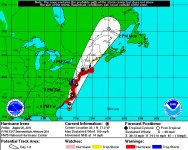crazyfingers
Well-known member
On the east coast of the US we have a hurricane on it's way. It's expected to go up the coast and maybe hit around New Jersey and keep going northeast as it weakens. It got me wondering what the birds do when the weather gets real bad.
I expect that ground birds just hunker down but do tree birds move to the ground? Would they fly 50-100 miles inland for the day and come back?
I'm not just thinking about the small ones but what also of the large ones? What would a red-tail hawk do in a 100 mile-per-hour wind? Find shelter I would hope. On the ground behind a big rock? The crows? I understand that they especially like to sleep in pine trees. Would they hunker down on the ground too?
Just thinking about this stuff as the storm is predicted to hit my area around Sunday August 28th*
(Subject to change I hope)
I expect that ground birds just hunker down but do tree birds move to the ground? Would they fly 50-100 miles inland for the day and come back?
I'm not just thinking about the small ones but what also of the large ones? What would a red-tail hawk do in a 100 mile-per-hour wind? Find shelter I would hope. On the ground behind a big rock? The crows? I understand that they especially like to sleep in pine trees. Would they hunker down on the ground too?
Just thinking about this stuff as the storm is predicted to hit my area around Sunday August 28th*
(Subject to change I hope)





